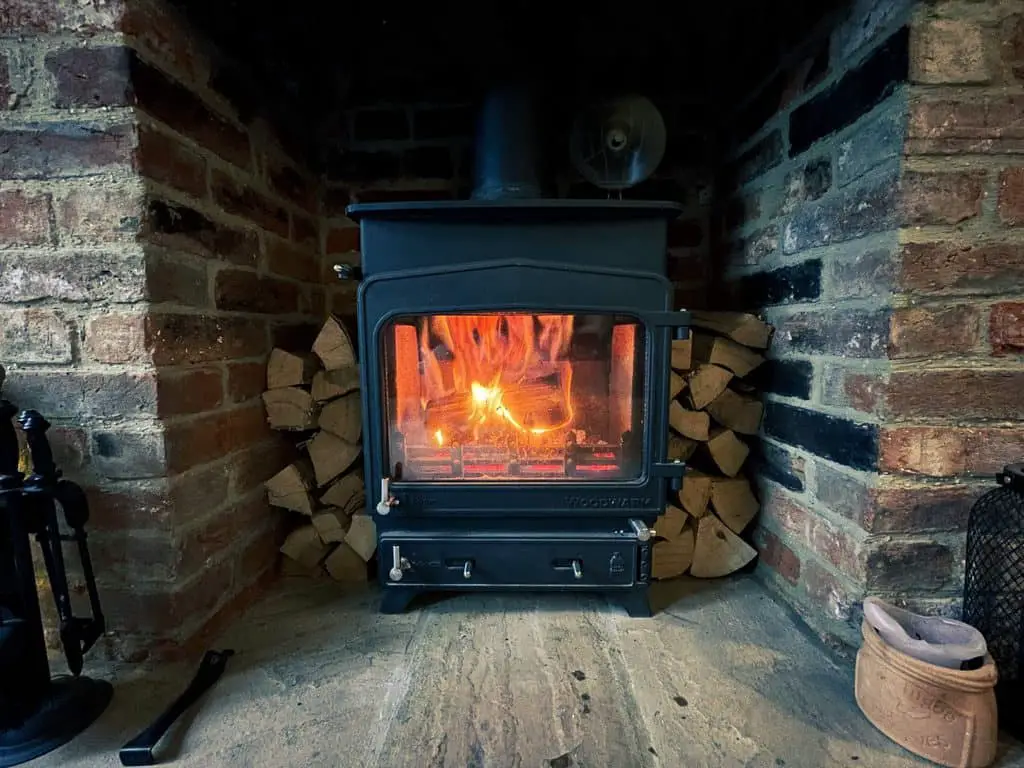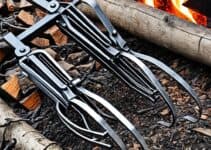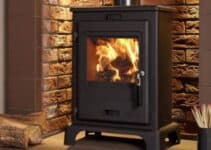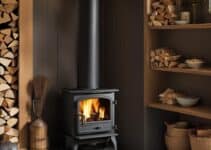If you’ve ever had a gas-burning appliance in your home, you’re probably already familiar with the risks of carbon monoxide. But have you ever wondered if log burners produce carbon monoxide and, if so, do you need to do anything about it?
That’s what we plan to cover in this article. Below, you’ll find out everything you need to know about log burners and carbon monoxide.
What is Carbon Monoxide?
A good place to start is by clarifying what is carbon monoxide. Carbon monoxide is an odourless gas consisting of one carbon and one oxygen atom.
It’s formed when a fuel is burnt without enough oxygen present. If there is enough oxygen present during combustion, we get carbon dioxide instead.
Carbon monoxide is very dangerous to your health. When you breathe it in, it bonds with the haemoglobin in your blood, which is what carries oxygen around your body.
In doing so, it reduces the amount of oxygen available in your bloodstream, leading to carbon monoxide poisoning.
Low levels of exposure lead to flu-like symptoms, including tiredness, headache, muscle pain and nausea. Higher levels of exposure lead to confusion, movement problems, unconsciousness, and death.
As such, it’s vital that we’re aware of carbon monoxide sources in our homes. Early symptoms of carbon monoxide poisoning are easy to miss and confuse with symptoms of other illnesses, meaning it can sometimes take a while to become aware of any leaks.

How to Tell If Carbon Monoxide is Present
Carbon monoxide is odourless, colourless and tasteless. As such, it’s difficult to know whether you have a leak unless you have a CO detector installed. Aside from that, the only way to know is if you experience any of the symptoms listed above.
While these can be symptoms of other illnesses, you should notice them clear up when you leave the room or your home (depending on how bad the leak is).
The half-life of carbon monoxide in the body is around 4 hours, meaning this is how long it’d take you to notice improvements in your health.
Of course, working out whether you’re suffering from CO poisoning isn’t the best way to know if there’s a leak in your home! A better option is to install a detector, which we discuss in more depth below.
0Does a Log Burner Produce Carbon Monoxide?
Log burners do produce carbon monoxide, along with a range of other waste products. As mentioned, carbon monoxide is produced when fuel isn’t burnt cleanly enough – such as if there isn’t good enough airflow. However, you’ll always get a small amount of carbon monoxide produced during combustion.
Proper ventilation is necessary to minimise the amount of carbon monoxide produced by burning fuel in your log burner.
This means having an open airway into the stove (its air vent) and an opening to the outside (the chimney). Ideally, the room in which the log burner is located should also have decent ventilation.
Appliances that burn gas and natural fuels produce carbon monoxide. It becomes an issue when a space isn’t properly ventilated and/or the appliance is poorly installed. Some examples include:
· An improperly maintained gas boiler in an airing cupboard.
·!– /wp:paragraph –>
· A portable petrol-powered generator in a caravan.
· A log burner with a blocked flue or chimney.
The bottom line is that carbon monoxide is produced by log burners. It occurs naturally, although there are things you can do to minimise its production, which we’ll discuss below.
Do You Need a Carbon Monoxide Detector with a Wood Burning Stove?
In short, yes, you should absolutely have a carbon monoxide detector if you have a wood burning stove. Considering they’re inexpensive and easy to install, you won’t lose anything by buying one.
In fact, you should have a carbon monoxide detector in every room that has a source of combustion. This might include the kitchen if you have a gas cooker, or near your airing cupboard (or wherever the boiler is located).
As of October 2022, it became a legal requirement in the UK for landlords to install CO detectors in any room that contained a combustion source (other than a gas cooker).
While this only applies to rental properties, it’s a good idea to take the advice on board if you’re a homeowner.
It’s worth noting that a carbon monoxide detector isn’t the same as a smoke detector. This might seem obvious, but it’s an important distinction to make.
A smoke detector monitors particles in the air that come from smoke, and goes off when they reach a certain level. A CO detector does the same but for levels of carbon monoxide.
You should ideally have both in the room that contains your log burner, as they relate to different problems.
You’d be more likely to have unsafe levels of carbon monoxide if the fire isn’t burning properly, whereas a smoke detector is more likely to go off if the room is on fire (or your chimney is blocked).
A smoke detector shouldn’t go off if your log burner is operating normally. If it does, you’ve either got a faulty model or there’s something wrong with your log burner. Either way, you’ll want to get it checked out.
How Do You Prevent Carbon Monoxide in a Wood Stove?
While you’ll never completely prevent carbon monoxide from being produced by your wood stove, you can certainly reduce the risk of it reaching dangerous levels. Luckily, the steps are pretty easy and are things you should be doing anyway.
You can minimise your risk of CO-related issues by doing the following:
Cleaning Your Chimney
Have your chimney swept before the start of every burning season (early-to-mid autumn). This ensures it’s clean and free from blockages, allowing for the correct airflow.
Have Your Flue and Other Hardware Inspected
If possible, you should have your flue and other log burner hardware inspected. A chimney sweep may be able to do this, or they should know someone who can. Again, aim to have it done annually before you plan to start using your log burner.
As with chimney sweeping, this is to ensure there are no blockages or cracks that could affect the airflow.
Clean Your Wood Stove
You should clean your wood stove at least once a week, and empty the ash pan every 1-2 days. Fires need a small bed of ash to burn better, but excessive build-up can affect airflow, resulting in higher levels of carbon monoxide.
Clean your stove with a vacuum cleaner and inspect the air valve. Ensure it’s not blocked and that air can flow freely when it’s open.
Check Your Fuel
Considering carbon monoxide can be produced when you burn standardised fuel (such as gas), it shouldn’t be a surprise that it can happen when burning non-standardised fuel (wood).
But what do we mean by this?
In short, natural gas is, generally speaking, always the same product. Wood, on the other hand, can vary. Whether it’s moisture levels, sap levels, wood hardness, or something else, these factors can all affect the quality of its combustion.
If you buy your wood, make sure its moisture level is below 20% and that it’s labelled for indoor burning. If you collect your own, ensure it’s properly seasoned, which can take anywhere from 6 months to 2 years.
Consider having someone teach you how to cut, season and store wood if you’re not sure what you’re doing.
How Much CO2 Does a Log Burner Produce?
CO2 is short for carbon dioxide, which isn’t the same as carbon monoxide (CO). CO2 production is an environmental concern rather than a health concern, as it’s essentially harmless (unless inhaled in quantities higher than normal for a long time).
But to answer the question, log burners produce around 0.008kg of carbon dioxide for every kWh (kilowatt hour) of energy produced. This is lower than gas combustion and electricity production.
Another important consideration is that wood is generally considered a carbon neutral fuel. Wood takes in CO2 as it grows, which is what’s released when you burn it.
As such, the level of carbon dioxide produced by log burners isn’t really a massive concern.
A bigger issue is the ultra-fine particulate matter produced by burning wood. It contributes to air pollution and can cause asthma-like symptoms. It’s unavoidable if you’re burning wood, regardless of whether it’s seasoned logs, sawdust pellets, or something else.
Provided your stove’s airflow is correct, this should disappear up the chimney. Ultra-fine particles can’t be detected by smoke detectors, so you won’t have any alerts if your stove is leaking higher amounts than normal into the room.
However, it shouldn’t be an issue as long as you keep your log burner clean.
Final Thoughts
Hopefully, this article has answered any questions you might have regarding log burners and carbon monoxide. The bottom line is that it’s always naturally produced by log burners, regardless of how efficient they are.
However, maintaining your stove and installing a carbon monoxide detector is enough to monitor the levels in your room. Provided you do this, you shouldn’t have any problems.



